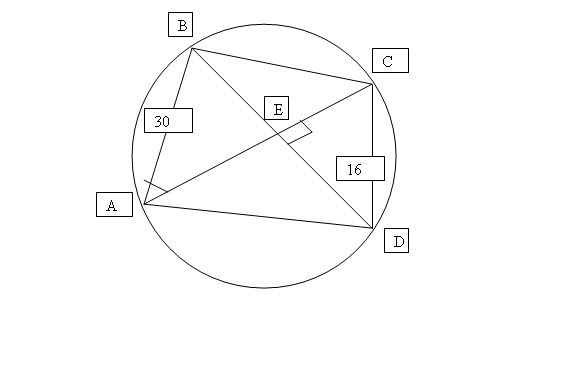A maths question - trigo
-

The diagram shows that A, B, C and D are 4 points on the circumference of a circle where AB = 3 cm , CD = 16 cm and angle BA = titer (the 0 with a line in the middle,haha). AC and BD are perpendicular to each other at E. Show that the are of the quadrilateral ABCD is (289 sin 0 + 240) cm2
take note that the 0 beside the "sin" is referring to titer or deteer or whatever. thanks.
-
Hi,
I think there is a typo error in the expression to be proved, as I obtained 289 sin 2(theta) + 240. Also, AB = 30 cm as shown on the diagram but it is written as 3 cm in the problem statement.
The approach:
1. angle ABE = angle CDB = theta (angles in the same segment).
2. From triangle ABE: AE = 30 cos (theta), BE = 30 sin (theta).
3. From triangle CDE: DE = 16 cos (theta), CE = 16 sin (theta).
4. Area = area of triangle ABC + area of triangle ADC
= 1/2 (30 cos theta + 16 sin theta)(30 sin theta) +
1/2 (30 cos theta + 16 sin theta)(16 cos theta).
5. Expand and simplify to 289 sin 2(theta) + 240.
Thanks!
Cheers,
Wen Shih -
Originally posted by wee_ws:
Hi,
I think there is a typo error in the expression to be proved, as I obtained 289 sin 2(theta) + 240. Also, AB = 30 cm as shown on the diagram but it is written as 3 cm in the problem statement.
The approach:
1. angle ABE = angle CDB = theta (angles in the same segment).
2. From triangle ABE: AE = 30 cos (theta), BE = 30 sin (theta).
3. From triangle CDE: DE = 16 cos (theta), CE = 16 sin (theta).
4. Area = area of triangle ABC + area of triangle ADC
= 1/2 (30 cos theta + 16 sin theta)(30 sin theta) +
1/2 (30 cos theta + 16 sin theta)(16 cos theta).
5. Expand and simplify to 289 sin 2(theta) + 240.
Thanks!
Cheers,
Wen Shih
Thanks wee_ws! My approach to this question was the same as yours. But unfortunately, the only difficulties I have is "Expand and simplify to 289 sin 2(theta) + 240.". I tried but I just can't transform the equation to the above. That's what initially led me to think that I might have done it incorrectly. Is there some way to reduce it to 289 sin 2(theta) + 240.? -
Hi,
Area = 1/2 (30 cos theta + 16 sin theta)(30 sin theta) +
1/2 (30 cos theta + 16 sin theta)(16 cos theta)
= 450 sin theta cos theta + 240 sin^2 theta
+ 240 cos^2 theta + 128 sin theta cos theta
= 240 + 289 (2 sin theta cos theta)
= 240 + 289 sin 2 theta.
Thanks!
Cheers,
Wen Shih -
This's quite a useful thread. Frankly speaking, I myself do not think of the equation being about to be multiplied in such a way. I only thought of factorising it.(since most of the times we are told to factorise to not "complicate" equations! Haha)
Thanks wee_ws and bonkysleuth!
-
Hi,
Welcome :)
Singapore-style mathematics is really very challenging at times :P
Cheers,
Wen Shih